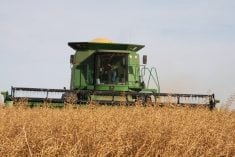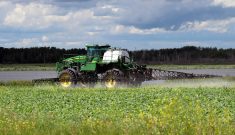While mustard growers face many of the same agronomic challenges as canola growers, they often find themselves with fewer crop protection options than canola growers do.
So when Bayer recently announced its Buteo Start seed treatment for flea beetles would be available for mustard seed, mustard farmers welcomed the news.
“That’s going to help us out quite a bit,” says Rick Mitzel, president of Sask Mustard. “Quite a few growers are looking forward to having that option in mustard for next year.”
Read Also

Cancer agency reclassifies another herbicide ‘probably carcinogenic’
The WHO’s cancer research agency has now put atrazine, a herbicide well known to corn growers, in the same potential-hazard category where the agency put glyphosate.
There are essentially no differences when it comes to strategies to combat flea beetles on canola or mustard.
In side-by-side studies, flea beetles were shown to prefer canola to mustard, but Mitzel said in practice any preference is indiscernible.
“The thought process on is that mustard was because it’s got a bitter taste to it when these flea beetles bite it, that they’d rather have canola, but that’s all gone now that we’re over 20 million acres of canola every year,” Mitzel says.
“There’s such a bank of flea beetles out there now that they eat everything, so they don’t slow down from mustard anymore.”
Despite those similarities, Bayer’s Buteo seed treatment was available for canola growers in 2020, and the latest registration is only available for M21 varieties of mustard seed.
Mitzel says this kind of delay is something he has to deal with regularly.
And because the latest flea beetle control products are barely able to keep up with the demands of canola growers, that delay can be an even more serious problem for mustard growers.
“The issue we run into a lot of times when there’s new products being developed is that they don’t consider mustard because it’s much fewer acres, obviously, than canola,” he says.
“We have to work with the companies and make sure that they include mustard. We need to have those products available so that mustard growers are on level footing with everybody else.”
The struggles for mustard growers don’t end at flea beetles or even insect control.
“If you look at weed control, just for starters, in canola everybody’s using herbicide-tolerant varieties — either a Liberty Link or Roundup Ready,” Mitzel says. “We’ll never develop a GMO mustard because our buyers and processors are not in favour of GMOs, and we have to work within the parameters that we have.”
Mitzel says one of the things his organization must consistently do to address these delays is lobby large crop protection companies to think about mustard when they’re launching a new herbicide.
“We can add 500,000 acres for them,” he says. “Normally, that’s enough for them to say, ‘That’s a nice little extra bit of business that we’ll take. OK, we are interested.'”
That 500,000 acres is a pretty stable number, and the industry doesn’t really need any more acres than that to keep up with demand in the mustard condiment market.
“We’ve always had a pretty steady supply of mustard in Western Canada. And when we need the acres to go up, farmers find a way to do it,” Mitzel says. “Farmers are pretty cognizant of the market for mustard.”
That said, Mitzel adds, they’re always looking for new growers, and every year, Sask Mustard sets up at Ag in Motion, where there’s a constant flow of farmers looking for new options coming by their plots.
“No matter what product you’re selling, there’s going to be farmer customers leaving and some new ones coming in,” he says.
Benefits
For the most part, Saskatchewan’s mustard acres are in the brown soil zones, with some in the dark brown, Mitzel explains. “The benefit of a mustard for a grower in the brown soil zone is that it gets him the ability to put an oilseed in his rotation.”
He says he often hears from farmers in those areas, who say they tried canola and needed 30 bushels an acre just to break even on that crop, but if they get 20 bushels an acre on mustard, they can actually make money at it.

“Mustard price is back down to more traditional levels right now, but even at that, the brown mustard market is probably 30 cents/lb., so you’re looking at 15 bucks a bushel,” Mitzel says. “If you look at the yellow mustard market, it’s probably closer to $20 a bushel.”
There is also some money to be saved on inputs, both in terms of fertilizer requirements and for disease and insect pressure.
“Once the crop’s up out of the ground and established, we don’t run into much issue with diseases like sclerotinia,” Mitzel says. “And some of the insect issues that canola has — diamondback moths, for example — are not as big an issue in mustard at all.”
Another benefit mustard can offer is fewer days to maturity.
“With canola, you’re probably running a little bit higher than that 100 days,” he says. “Mustard is equivalent to barley. It’s about 90 days. So it helps you spread your harvest out.”
But while these comparisons are all with canola, because of the agronomic similarities, Mitzel says he doesn’t really compete with canola.
“If you grow canola, you can’t grow mustard on that field for another four to five years, until all the volunteer canola has gone from it, because you can’t have the GMO contamination,” Mitzel says, adding that farmers usually have land designated specifically for mustard.
“A lot of growers will allot two or three quarters to be the land that has mustard as the oilseed in rotation,” he said. “They segregated out, and they plan for it in the future.”
















